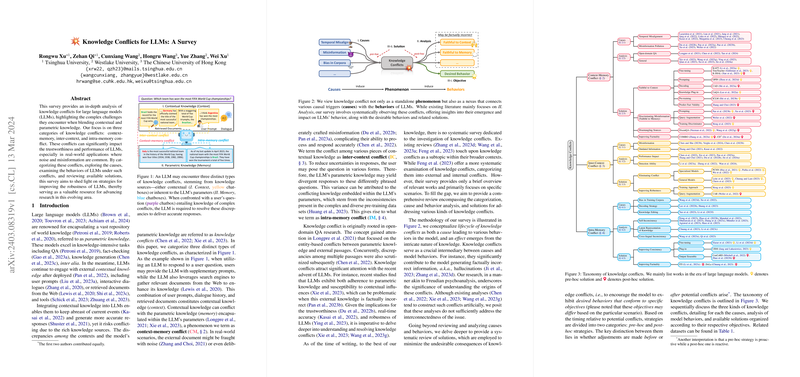Exploring Knowledge Conflicts in LLMs: Categorization, Causes, and Solutions
In the field of LLMs, knowledge conflicts are inevitable due to the vast and diverse sources of information that feed these models. A systematic exploration of this area reveals intricate challenges LLMs face in reconciling contradictions among the information they process. This survey explores the nuanced categories of knowledge conflicts LLMs encounter, namely, context-memory, inter-context, and intra-memory conflicts, each accompanied by unique triggers and behavioral outcomes. Furthermore, it explores the practical and theoretical implications of these conflicts on the trustworthiness and performance of LLMs and discusses the current strategies devised to mitigate these issues.
Context-Memory Conflict
Context-memory conflict arises when an LLM's built-in (parametric) knowledge conflicts with new external (contextual) information supplied during its application. Causes could be categorized broadly into temporal misalignment and misinformation pollution, challenging the trustworthiness and real-time accuracy of models. Analytically, LLMs exhibit a varied yet consistent preference towards semantically coherent, logical, and compelling knowledge, regardless of whether it originates from context or memory. Solution-wise, strategies range from pre-hoc solutions like fine-tuning and knowledge plug-in, aimed at adapting the model towards prioritizing contextual information, to post-hoc strategies like predicting fact validity, to ensure that models can discern and adjust based on the reliability of the information source.
Inter-Context Conflict
Inter-context conflict is marked by discrepancies within the external information retrieved by or fed into the model. Predominantly sourced from misinformation or outdated information, this form of conflict significantly impacts LLM performance. Models struggling with this conflict type show a marked tendency towards over-relying on parametric knowledge when external conflicts arise. Efforts to combat these conflicts include leveraging specialized models to eliminate contradiction or augmenting query strategies to enhance the robustness of models against conflicting information.
Intra-Memory Conflict
Intra-memory conflict refers to the discrepancies within the LLM's parametric knowledge, resulting in inconsistent outputs for semantically equivalent but syntactically different inputs. Such inconsistencies undermine the reliability and utility of LLMs across different applications. The root causes are identified as biases in the training data, decoding strategies, and post-update knowledge editing. Existing research suggests a focus on improving the consistency and factuality of model responses, with proposed solutions encompassing both the training phase and the post-hoc processing phase, aiming to refine parameter knowledge and regulate model behavior.
Challenges and Future Directions
The survey outlines several unaddressed challenges and potential research directions. A critical concern is the practicality of current solutions, which mostly address artificially constructed knowledge conflicts, highlighting the need for studies exploring conflicts "in the wild," especially in the context of retrieval-augmented systems. Furthermore, there's a call for deeper investigation into the interplay among different types of conflicts and their compounded effects on LLM behavior. The ethics and implications of handling misinformation, especially in sensitive applications, also remain an area ripe for exploration.
Conclusion
This survey provides a comprehensive overview of the current state of research on knowledge conflicts in LLMs, offering insights into conflict categorization, underlying causes, model behaviors, and resolution strategies. As LLMs continue to evolve and integrate into various aspects of technology and daily life, understanding and addressing knowledge conflicts will be paramount in ensuring their trustworthiness, reliability, and utility.
